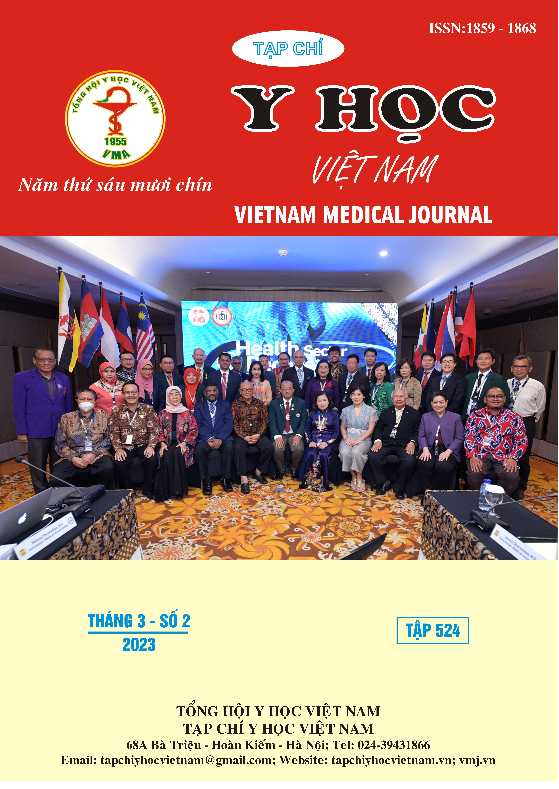CLINICAL AND PARACLINICAL CHARACTERISTICS OF POST - OPERATIVE ENDOPHTHALMITIS AT VIETNAM NATIONAL EYE HOSPITAL FROM 2016 TO 2020
Main Article Content
Abstract
Objectives: To describe clinical and paraclinical characteristics of post - operative endophthalmitis at Vietnam National Eye Hospital from 2016 to 2020. Subjects and Methods: It was a retrospective, case series descriptive study including 170 patients diagnosed with post-operative endophthalmitis at Vietnam National Eye Hospital from 2016 to 2020. The research valuables included: age, gender, diseased eye, morphologies of post - operative endophthalmitis , systemic pathology, time from onset to hospital admission, initial visual acuity (VA), initial intraocular pressure, corneal status, anterior chamber status, pupillary reflex and vitreous opacity. Results: The average number of patients diagnosed with post - operative endophthalmitis was 170 cases per year. The mean age of patients in our study group was 50.39 ± 20.64. The age distribution was different among different endophthalmitis morphology groups. Most of patients in group of post cataract surgery endophthalmitis were over 60 years old. Meanwhile, 20.6% of patients suffering from post - pars plana vitreoretinal surgery endophthalmitis was in adulthood. There was no difference in the prevalence of men and women (male/female=1.33/1). The right and left eyes were equally affected. There was no significant difference between the two eyes. Systemic disease was seen in 20.6% of patients. Hypertension, diabetes, and respiratory inflammation were the most common systemic diseases. Post - cataract surgery endophthalmitis was the most common morphology (54.7%). Meanwhile, the proportions of post - pars plana surgery and other surgery endophthalmitis were quite equal (20.6% and 20.0%, respectively). The percentage of endophthmitis after trabeculotomy with or without intraocular lens implantation was least (4.7%). Initial VA was mostly low with 35.3% of patients having VA of light perception and 44.7% having VA of hand motion (HM). Corneal opacity and hypotony were common anterior chamber injuries, accounting for 71.2% and 81.2%, respectively. Consequently, vitreous cannot been observed in 78.1% of patients due to serve anterior chamber inflammation. The rest (21.9%) cannot been evaluated the retina because of grade 5 of vitreous opacity. Conclusion: The age distribution was different in different morphology groups. The majority of patients with post - cataract surgery and trabeculotomy endophthalmitis were elderly. The common age groups of patients with post - pars plana and other surgery were children and middle age. Male and female prevalence were equal. Disease rate depended on the forms of intraocular surgery. Post – cataract surgery endophthalmitis was the most common morphology. Most patients had spreading inflammation in both anterior and posterior chamber.
Article Details
Keywords
Endophthalmitis, post - operative endophthamitis
References
2. Das T, Kunimoto DY, Sharma S, et al. (2005), Relationship between clinical presentation and visual outcome in postoperative and posttraumatic endophthalmitis in south central India. Indian J Ophthalmol. 53(1):5-16.
3. Rahimi M, Ghassemifar V, Nowroozzadeh MH (2012), Outcome of endophthalmitis treatment in a tertiary referral center in southern iran. Middle East African journal of ophthalmology. 19(1):107-114.
4. Friling E, Johansson B, Lundström M, Montan P (2022), Postoperative Endophthalmitis in Immediate Sequential Bilateral Cataract Surgery: A Nationwide Registry Study. Ophthalmology. 129(1):26-34.
5. Phillips WB, 2nd, Tasman WS (1994), Postoperative endophthalmitis in association with diabetes mellitus. Ophthalmology. 101(3):508-518.
6. Gondhale H, Jaichandran VV, Jambulingam M, et al. (2021), Distribution and risk factors of postoperative endophthalmitis in people with diabetes. Indian J Ophthalmol. 69(11):3329-3334.


